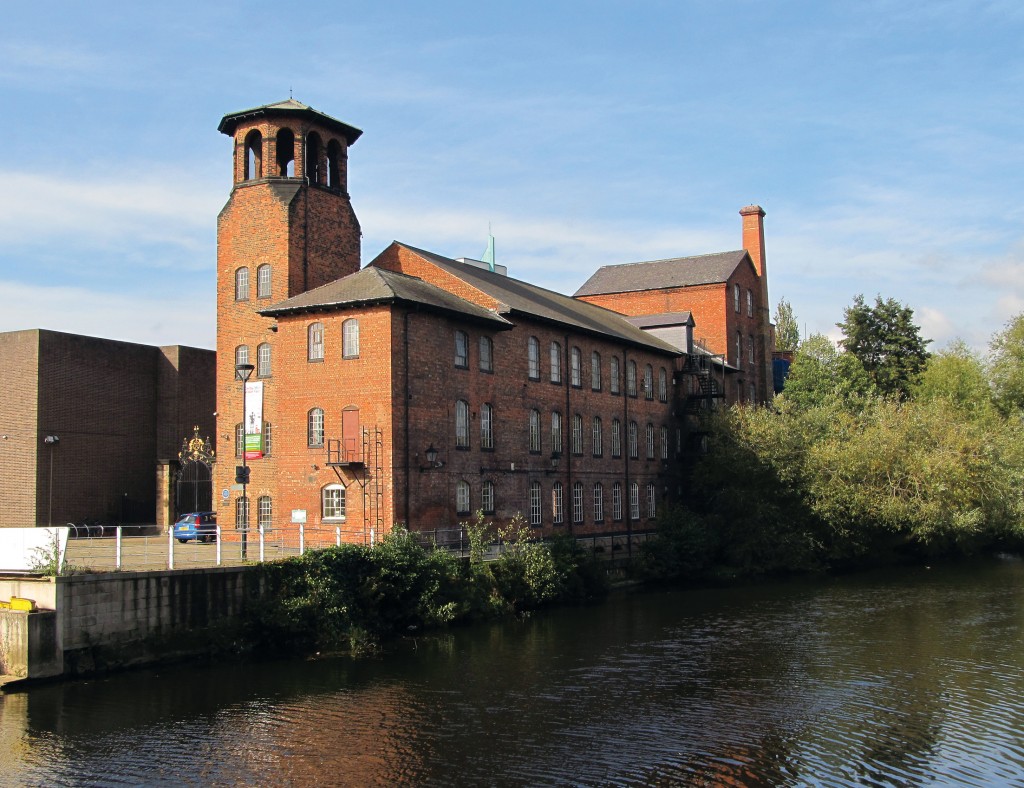Key Sites – The Silk Mill

Key Sites – The Silk Mill
The story of how the large-scale manufacturing of high quality silk thread arrived in Derby early in the eighteenth century is now very much better understood thanks to recent research by Anthony Calladine. It is clear there were several crucial factors and these include the driving enthusiasm and inventive genius of a few key individuals. Silk making in late seventeenth century England had grown during a period when fashion demanded luxury silk items, a demand which was met, in part, by the Huguenot refugees from France who settled in England, many of whom were skilled silk weavers.
At the end of the seventeenth century, Thomas Cotchett, a middle-aged Derby solicitor, became interested in the commercial possibilities of silk manufacture using water-powered machinery. He turned to George Sorocold, an engineer who had recently been employed to supply Derby with piped water, to build him a water-powered mill on an island in the Derwent near the centre of Derby. Cotchett installed a number of “Dutch machines” but the project was not a success because, according to a contemporary witness, it was inadequately equipped. The experiment might have ended here but one of Cotchett’s employees, John Lombe, was determined to take things further. He was convinced that if the secret Italian process could be introduced to the country there would be a large market for the high quality silk it would produce. Lombe carried out a daring piece of industrial espionage, and returned to England with a number of Italian workmen and detailed drawings of the Piedmontese throwing machines. In 1719 Thomas Lombe was granted a 14 year patent, and in 1721 he and his brother began to build a mill adjacent to Cotchett’s mill and as a near neighbour of the Derby corn mill. Calladine suggests that Lombe had been actively encouraged to set up his mill in Derby by some of the town’s most prominent citizens who were anxious to secure a new industry for the neighbourhood.
The Italian machines did not require a large power source to drive them and Lombe’s mill was served by a single undershot wheel 7m in diameter and probably about 1.8m broad. The mill used the weir and tail-race of the town corn mill, though the weir may have been raised.
The mill was five storeys high, 33.5m long and 12m wide.
The storeys were supported on stone arches which allowed the river Derwent when in flood to pass through them. A shallow pitched roof was concealed behind a parapet and the building was equipped with large sash windows 1.8m high and 0.96m wide. A second building, the doubling shop, was constructed in line with the mill. This contained the doubling machinery which was all hand powered. There was also a warehouse and service space which included a carpenter’s room and the mill offices.
Lombe’s mill contained many elements of the modern factory. The machinery was driven from a common power source and housed in a large multi-storeyed building. A large labour force was employed – by 1730, 300 people are said to have been at work in this enterprise – and there is some indication that the mill may have had a form of hot-air heating system similar to those found later in the Arkwright cotton mills.
The Lombe experiment was copied in Stockport, Macclesfield, Congleton and elsewhere, but only at Congleton was a mill built on a similar scale. Thirty years after the expiry of Lombe’s patent only seven mills had been built; though a very much larger number were manufacturing tram, a lower quality product.
Lombe’s achievements
The significance of Lombe’s achievements should not be measured wholly in terms of the growth and extent of the mechanised silk throwing industry stimulated by his example. The silk industry was never destined to serve a large market. Of greater importance by far was the system of working and the organisation of the labour force around the rigid demands of a common power source which the Derby mill bequeathed. As the Strutts made clear, it was an inheritance the later factory masters well understood. The degree to which Lombe’s mill offered succeeding generations an example of mill design is more difficult to assess. Was it a coincidence that Masson Mill as it was first built, had a high parapet concealing a low pitched roof which gave it a striking similarity to the Derby Silk Mill? The first mill at Cromford may also have had a parapet to the roof judging from one early illustration, though this is not confirmed by other depictions. Certainly the first Cromford Mill followed the Silk Mill in adopting sash windows and, as has been pointed out, there is the possibility that the later mills might have borrowed an earlier heating system. There are, however, important differences.
The later cotton mills were built significantly narrower than Lombe’s mill. Not having to accommodate such bulky machinery the extra width offered no advantage. There may also have been differences in the floor to ceiling heights.
Beyond this point comparison is unhelpful. The processes which are subsumed within the term “spinning” are, by comparison with throwing silk, so numerous and relatively more complicated that not even Richard Arkwright, as one of his contemporaries put it “allowed by all his acquaintants to be a very ingenious man” was able, or the genius of William Strutt was sufficient, to mechanise every step of the passage of raw cotton to spun yarn. It was, however, for the degree to which he was successful that Richard Arkwright won the accolade “Father of the Factory System”.
The Silk Mill
Derby Silk Mill (1721, Rebuilt 1910 – Listed Grade II)
Derby Silk Mill lies besides the river Derwent, on the north-eastern edge of the city centre. Today, it has a surprisingly tranquil setting, given its loca-tion within an urban environment. Relatively little remains of the original physical structure of Lombe’s Mill.
The massive stone arches that provided the foundations of the eastern side of the five-storey “Italian Works”, as Lombe’s Mill was known, can still be seen running along the western bank of the river Derwent. The remainder of the old mill was destroyed by fire in 1910 and rebuilt three storeys high. The adjacent stair tower on the south-western corner of the building, per-haps its most distinctive architectural feature, was rebuilt using the original bricks, together with the nineteenth century belfry.
The courtyard on the western side of the building was originally occupied by the mill race. The course of the flume, which carried the water back to the river Derwent, can still be seen within the landscaped gardens to the south of the mill.
The early industrial buildings which adjoined the mill on the northern side, including the first silk mill and town corn mills, have disappeared, and their place is now occupied by a brick extension that is contemporary with the present mill building.
Wrought Iron Gates (1725 – Listed Grade II)
The original wrought iron gates made for the mill in 1725 by the renowned Derbyshire craftsman, Robert Bakewell, have been restored and now stand at the entrance to a courtyard on the western side of the mill building.

